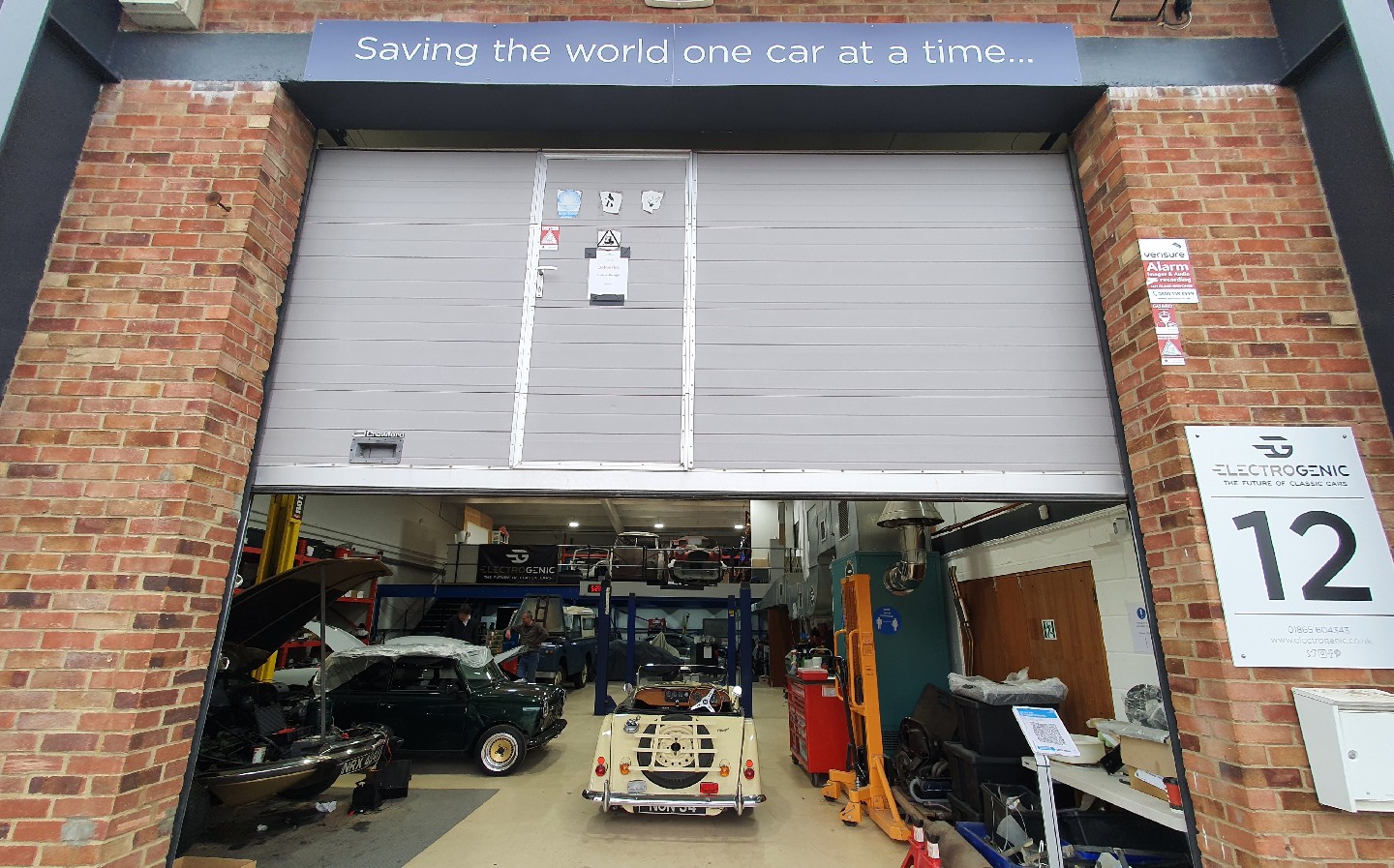Classic car electric conversion is on the rise – we visit one specialist to find out why
Is it sacrilege or do we need to get with the programme?
THE BANNER over Electrogenic’s workshop, on an industrial estate just outside Oxford, reads “Saving the world one car at a time…”. It’s a fairly inconspicuous sign but the message is not lacking in ambition.
Enter and you will discover all manner of timeless classic cars in various states of repair. Our visit revealed a Series II Land Rover, TVR Cerbera, Porsche 356 coupé, Citroën DS and, nearest the shutters, a 1957 Morgan 4/4. But here’s where the toes of classic car enthusiasts might begin to curl: all of the cars within are being converted to run on electric power.
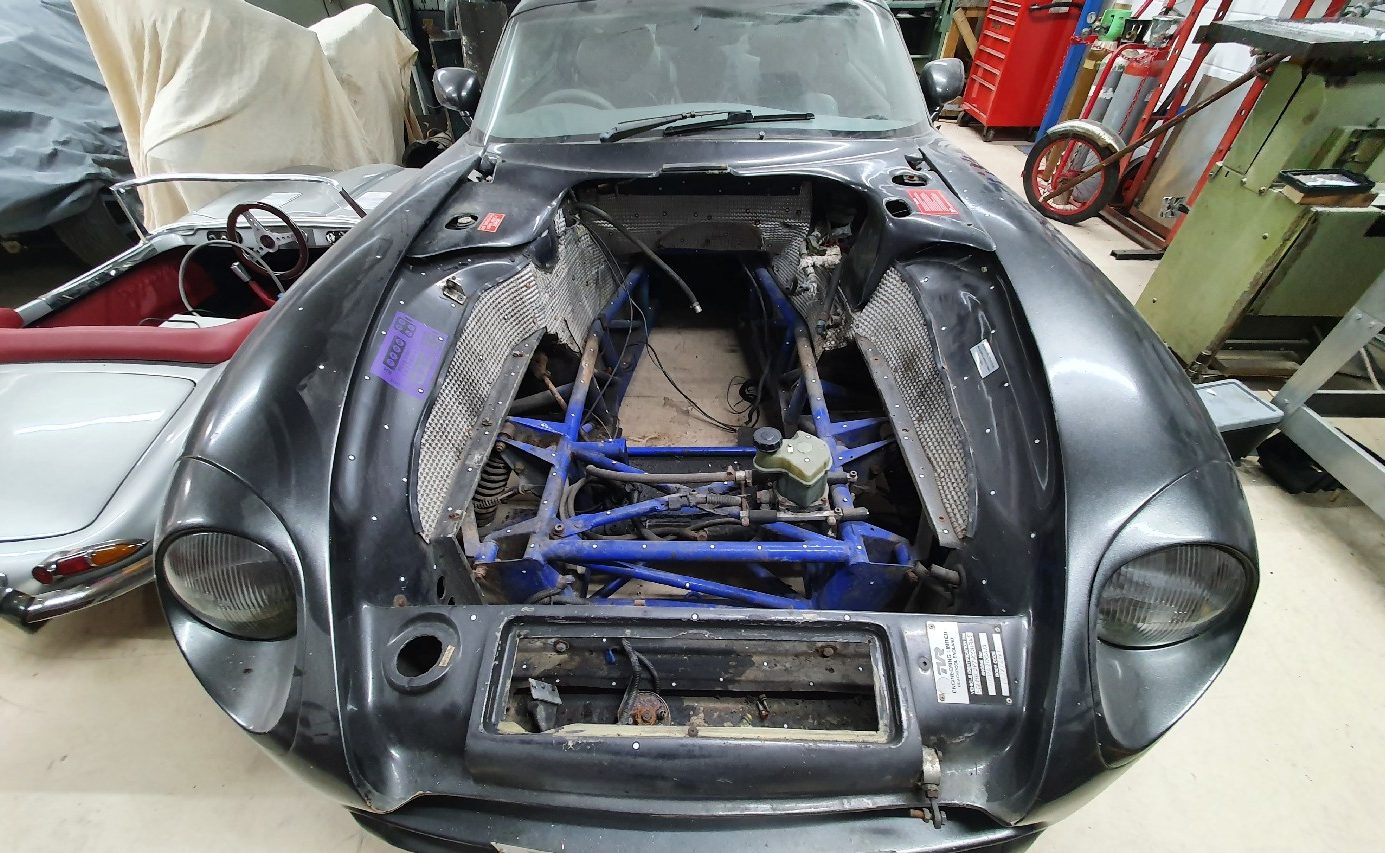
A client’s TVR Cerbera with its engine removed. It’s likely the battery modules will be place along the central transmission tunnel.
Ripping out a 356’s four-cylinder air-cooled engine, or the Cerbera’s 4.2-litre V8, and replacing it with an electric motor and lithium-ion battery packs – that’s the stuff of nightmares for some enthusiasts. The engine is often thought of as the heart and soul of a car; is it not seen as sacrilege in the classic car community?
“We’ve never had anybody come up to us and say that,” says Steve Drummond, co-founder and director of Electrogenic. “There’s a big online community of enthusiasts and our profile is widening now, and so we’re getting noticed by people who aren’t conversion [to electric] enthusiasts. You get some trolling but the answer is, you don’t know what it’s like until you’ve driven it.”
Why convert to electric?
There are multiple reasons for swapping out petrol for electric power, Drummond says, but primarily he claims it makes the cars “better” to drive – when looked at without rose-tinted spectacles.
He cites the example of the Triumph Stag owned by business partner and Electrogenic co-founder Ian Newstead: “It’s the immediacy [of the acceleration]. You’ve got all the torque there – much more than it had originally, in fact, and it’s immediately available to you. It’s quick and responsive, it’s light on its feet; it’s a joy to drive.”
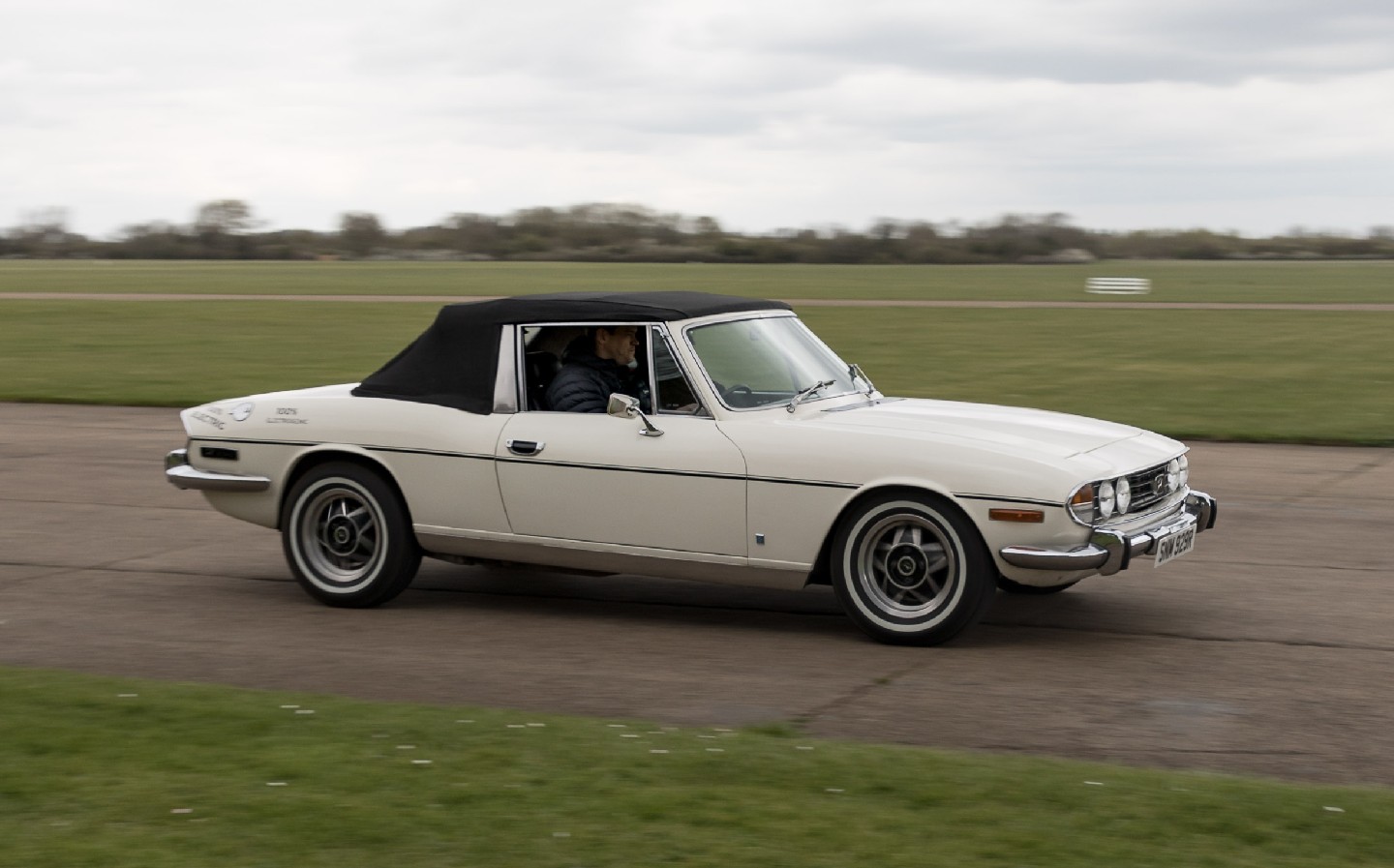
Will Dron tries out Ian Newstead’s electric Triumph Stag – believed to be the first of its kind to be converted.
Another advantage is reducing the chances of mechanical failure. “The Stag is a classic example; it had a notoriously unreliable engine,” he says. “It sounded beautiful, yes, but was well known for its unreliability.”
By replacing the engine with an electric motor, which has just one moving part, you dramatically reduce the chances that you’ll end up standing by the side of the road waiting for a breakdown truck.
“People talk about ‘range’ with electric cars but what’s the range of a classic? The end of the street?”
Newstead has clearly been let down by a classic car or two: “Try explaining to the wife [before a journey] that you’re going in the classic car, and it might make it wherever you’re going but then again it might not.”
“With classic cars you don’t always know if you’re getting home again,” adds Drummond. “People talk about ‘range’ with electric cars [how far you can travel per charge of the battery] but what’s the range of a classic? The end of the street? To quote a number of our customers, it gives a car whole new lease of life. Everything we put in the cars is good for 200,000 miles, 50 years.”
Isn’t that part of the romance of owning a classic car? Their idiosyncrasies; the fact that they’re inherently tricky to drive (or, at least, drive well) and the care that goes into keeping them running, are part of the appeal.
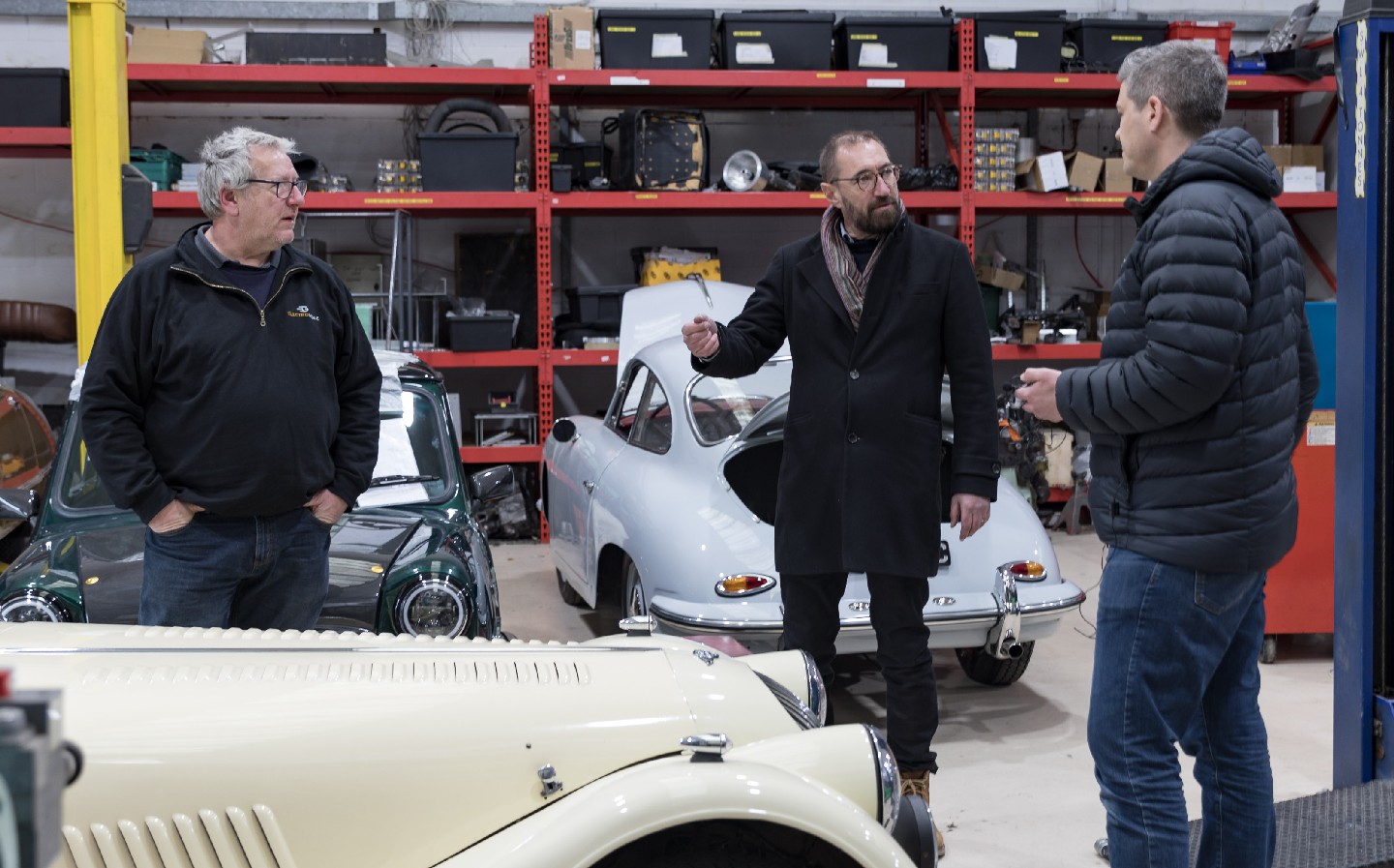
Newstead (left) and Drummond (centre) explain to Dron why customers choose to convert classic cars to electric power.
“It is, but it also makes it inaccessible,” counters Drummond. “You have to keep it going, so you either have to employ a mechanic or you have to do it all yourself, which is hard, hard yards.
“I had an old Beetle that I could drive because I loved it, but nobody else in my family could even start it. After an electric conversion, the whole family was zipping around in it. They used to fight over it, in fact. It was such fun.”
Newstead reckons conversion is especially suited to households that have a car each for the two adult partners plus a prized classic car for occasional use. By converting the classic to electric it would be possible to get rid of the one of the other cars, he argues, because they’re so easy to drive and won’t leave you stranded.
What about the noise, I ask. The music of a classic engine is very much part of the intoxicating effect. The reply suggests the other benefits outweigh the charm of a sonorous exhaust: “It means I’m able to turn the radio down a bit,” smiles Newstead.
“Roll forward 15 years and there will be fewer petrol cars. Then there are fewer economic incentives for petrol stations to exist”
Another possible benefit springs to mind: given the ban on sales of new petrol and diesel cars from 2030 amid increasing animosity towards vehicle emissions, and calls for combustion engine cars to be banned from city centres, is electric conversion future-proofing your classic car?
“Totally,” says Drummond. “And not just in terms of being allowed to drive on certain roads. Roll forward 15 years and there will be fewer and fewer petrol cars. Then there are fewer and fewer economic incentives for petrol stations to exist. And then you will find that range anxiety [the fear of running out of fuel] is not about electric cars anymore but the other way around.”
A final reason one might decide to replace the engine with an electric motor is simply that it’s in such poor health that an intervention of some kind is needed. An extreme example would be a barn find, which might have an engine that is completely seized and can’t be saved, though there may be many more much-loved runners that reach an age at which an engine rebuild or replacement is the only way to keep it running.
“At that point, you might think this is the time to do it,” says Drummond. “A friend of mine with an E-type (Jaguar) just paid £50,000 to have his engine rebuilt. That’s not small money.”
A Porsche 911 engine rebuild would cost up to £65,000, adds Newstead.
Amazingly, the owner of the Porsche 356 undergoing conversion at Electrogenic at the time of our visit recently paid £40,000 to have it rebuilt. Despite only having covered 600 miles since then, the owner wants to install an electric motor, which is incomprehensible until you realise that the pristine engine could now be stored as a museum piece at the owner’s home – a reminder of how we used to drive. The mind wanders to images of future generations asking their parents what on earth is that shiny metal thing with pistons and valves.
The birth of Electrogenic
Electrogenic was founded about three and a half years ago. Drummond has a background in environmental engineering and designed power stations for a living (“Coal, oil, gas, nuclear, solar, wind… you name it”). He also launched the first ever online carbon trading platform and was involved in the first plans for the Severn Estuary tidal generator in the 1980s.

The Morgan is a trickier car to convert than the Stag, as space in the engine bay is more restricted.
Newstead, meanwhile, comes from a very different background. A traditional car mechanic by trade, he took some convincing about the benefits of electric cars. He had in mind milk floats and couldn’t understand the appeal. It was his 16-year-old daughter who opened his eyes to the potential of electric power by showing him some drag racing videos on YouTube.
“I couldn’t believe it,” he says.
The pair’s first project together involved converting Drummond’s own split-screen VW Campervan.
“The campervan’s natural environment is the beach but we couldn’t take it down the hill to get there as it didn’t have the power to get back.” The electric motor allowed it to scale the hill with ease, he says.
“My petrol campervan couldn’t get back up the hill from the beach”
That first project was stolen and never recovered, sadly, but the premise seemed like a sound one and, following further research and a trip to America to check out the latest developments in classic car electric vehicle (EV) conversion over there, Drummond realised there was a business case and the two men formed Electrogenic in late 2017.
“It seemed to me that the tech was at a point, or was just coming to a point, where you could make an electric version of a classic car that was worth owning,” Drummond tells me. “Before that, probably not – you’d have to have been a real enthusiast. You could see that it was becoming possible to do it well.”
Electric car conversions: How to convert a classic car to electric
Electrogenic’s first official conversion was Drummond’s own VW Beetle. Over a number of additional projects they honed their conversion skills. The company found that off-the-shelf components often weren’t up to the task so they started making their own parts, which turned into making their own electronics.
“If you buy a charging system and a battery management system and a motor, and they’re all from different manufacturers, they’re not designed to talk to each other,” says Drummond.
“It’s ‘bitsa’,” chimes in Newstead. “Bitsa this, bitsa that.”
“You get a Microsoft instead of an Apple Mac,” continues Drummond. “You have to stitch them together, with compromises to make everything talk properly to each other. You’re not getting a unified whole. These days [with their own kit] we have control over the entire electronic environment.”
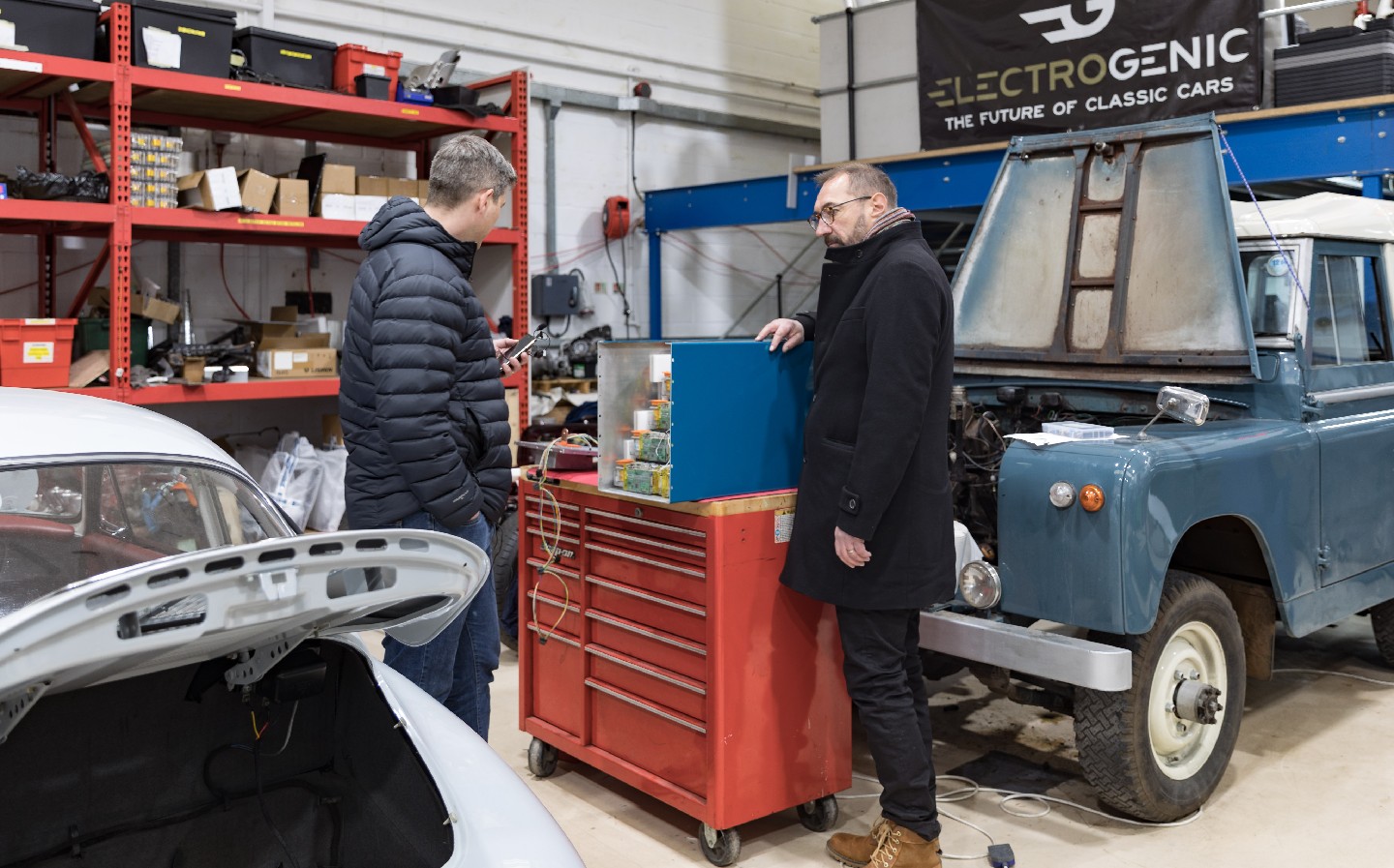
Drummond shows Dron a consignment of Tesla battery modules, ready for installation.
They do buy in battery packs, of course. The supplier depends on the job, as different packs come in different shapes, and one might be more suited to a particular classic car, in terms of packaging, than another. I’m shown a consignment of Tesla-supplied battery modules (yes, they do that), which look as simple as hundreds of AA batteries joined together in a clear plastic case. Interestingly, the Tesla packs are more affordable than the others used by Electrogenic.
Each car presents its own challenges during conversion and the cost of classic car electric conversion varies.
“It really depends,” says Drummond. “It starts around just under £30,000 plus VAT and goes up to whatever you want. They’re all bespoke conversions, and that’s the joy of it.”
Newstead’s 1976 Stag – the first to receive an electric conversion according to the Triumph Stag Owners’ Club – has had its 3.0-litre V8 engine removed but in its place are battery packs mounted in a 90-degree V formation as an homage to the original powerplant.
“Beetles and early Porsches were back-end heavy, front end light, and don’t steer so well. We can improve the handling”
More battery modules are mounted where the fuel tank and spare wheel would normally be located, adding 37kWh of total energy storage for a claimed range of around 150 miles. Neat touches include positioning the 50kW Type 2 charging socket under the original fuel filler cap and keeping the cockpit looking largely original, so to a casual observer the only clue that it’s not petrol-powered is when it Newstead climbs in and drives away in near silence.
Although overall weight is the same, the placement of the battery modules results in 50:50 weight distribution, Drummond claims, though its configuration means that the front end is actually lighter that it was before conversion. To compensate, Newstead swapped out the springs for more pliant ones, which ensures the ride height remains the same. In other projects, the suspension will often remain original, though in a recent Morris Minor project the clever Issigonis-designed suspension system proved a challenge, so the torsion bar was adjusted to suit the new running gear.
Each car sent to Electrogenic goes through a “reception process” that includes driving on track to get a feel for the brakes, handling, performance and ride quality. Then Drummond and Newstead will talk to the customer about the possibility of improving the car through conversion.
“This is another good thing about it,” says Drummond. “For example, Beetles and early Porsches were back-end heavy, front end light, and don’t steer so well. We can put weight in the front that actually helps the handling of the car.”
Start off in first, second or third — the instant torque of the electric motor means any gear will do
The Stag’s ‘Hyper9’ high-voltage brushless electric motor sits underneath the battery V, delivering 80kW of power (107hp) and 173 lb-ft of torque, which compares favourably with the original V8’s 145bhp and 170 lb-ft.
Also under the bonnet are the original power steering pump and vacuum pump for the brake servo, though a new electric heater has been added to compensate for the fact that heating can’t come from the V8 engine. A new kill switch is also added to enable the high voltage system to be disconnected in the event of a crash.
The challenges of bespoke conversions
Amazingly, power is sent to the rear wheels via the Stag’s original four-speed manual transmission, as Electrogenic often retains the manual gearboxes during the conversion. To drive, you still use the clutch to change gears but setting off and coming to a halt involves not using the clutch at all, which feels thoroughly odd during a first drive. What’s more, when setting off you can simply pick a gear — first, second or third, the instant torque of the electric motor means any of them will do.
“You tend to drive around in third if you’re feeling relaxed, fourth on the motorway,” explains Drummond. “Second, if you want to squeal the tyres and first if you want to destroy them.”
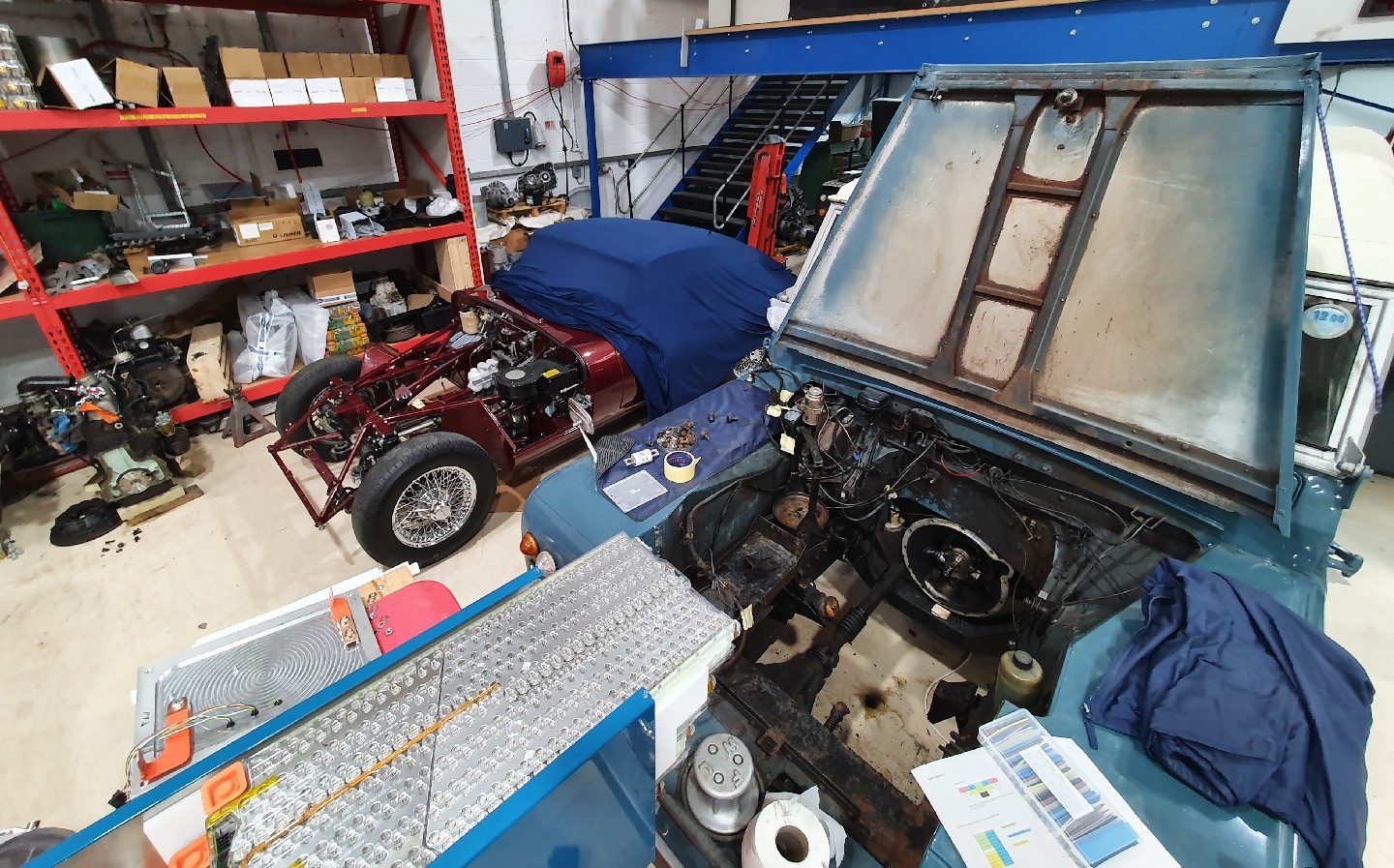
A Jaguar E-type and Land Rover Series II. The Land Rover my or may not end up with its original transmission.
Not all owners want to keep the gearbox, though. The Porsche 356 will have its transmission removed (“The old ratios are quite close which means you have to change gear a lot”), and Drummond and Newstead are still debating whether or not to remove the ‘box in the Series II Land Rover. They might ditch it, they tell me, but still send power through the transfer box, allowing high and low range for off-roading. Of course, ultimately it’s up to the client.
The 1957 Morgan 4/4 was another challenge, as the car had a non-standard gearbox that the owner wanted to keep but a tricky reverse gear that he wanted to bypass. So while the finished car retains all the forward gears, engaging reverse involves flicking a switch.
Of course, the Morgan’s packaging differs significantly from the Stag’s. While it received the same electric motor and 37kWh battery capacity as found in the Triumph (the Morgan’s owner wanted a larger battery, in fact, for increased range, but Electrogenic convinced him that less weight would result in a more satisfying driving experience), the engine bay is more restricted, with the passenger footwell and steering column encroaching on the available space, so the front battery modules are mounted towards the top of the bay. Five Tesla modules are mounted at the front of the car and two are positioned at the rear, where the fuel tank was.
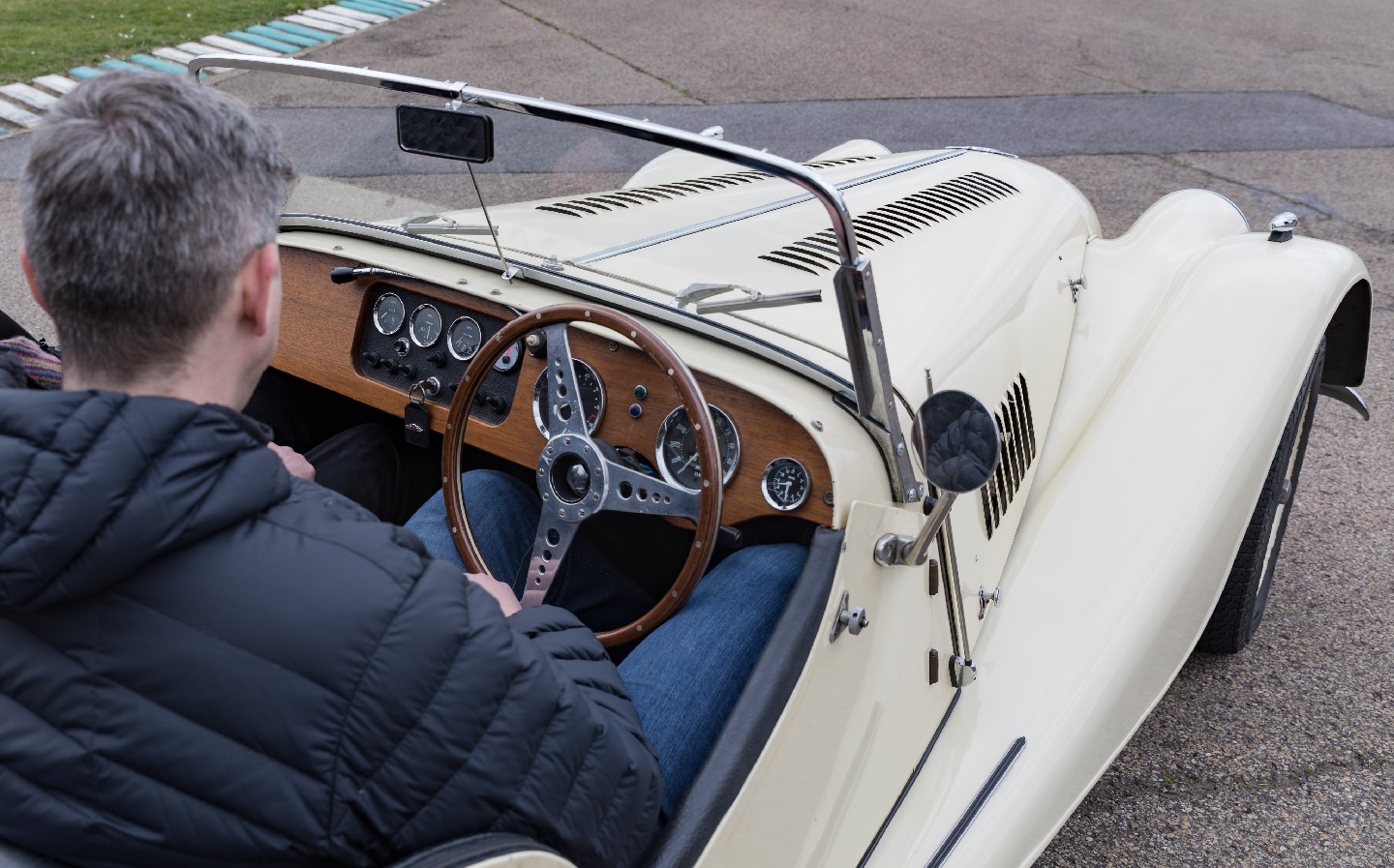
The cockpits are largely original, but fully working.
“There’s not a lot of space to play with,” says Drummond. “It’s a lot of problem solving all the time.”
Perhaps the biggest challenge for the team during my visit was the Citroën DS, which is famous for its hydropneumatic suspension system, powered by a seven-piston hydraulic pump run off the engine. The same hydraulics system is linked to the power steering, brakes, gearbox and clutch assembly.
But without an engine, Electrogenic needed to find a new way to power it all electrically, and the solution was a new mechanical pump with pressure switches, connected to the 12-volt battery (which even modern electric cars retain to power the lights, heating and infotainment systems).
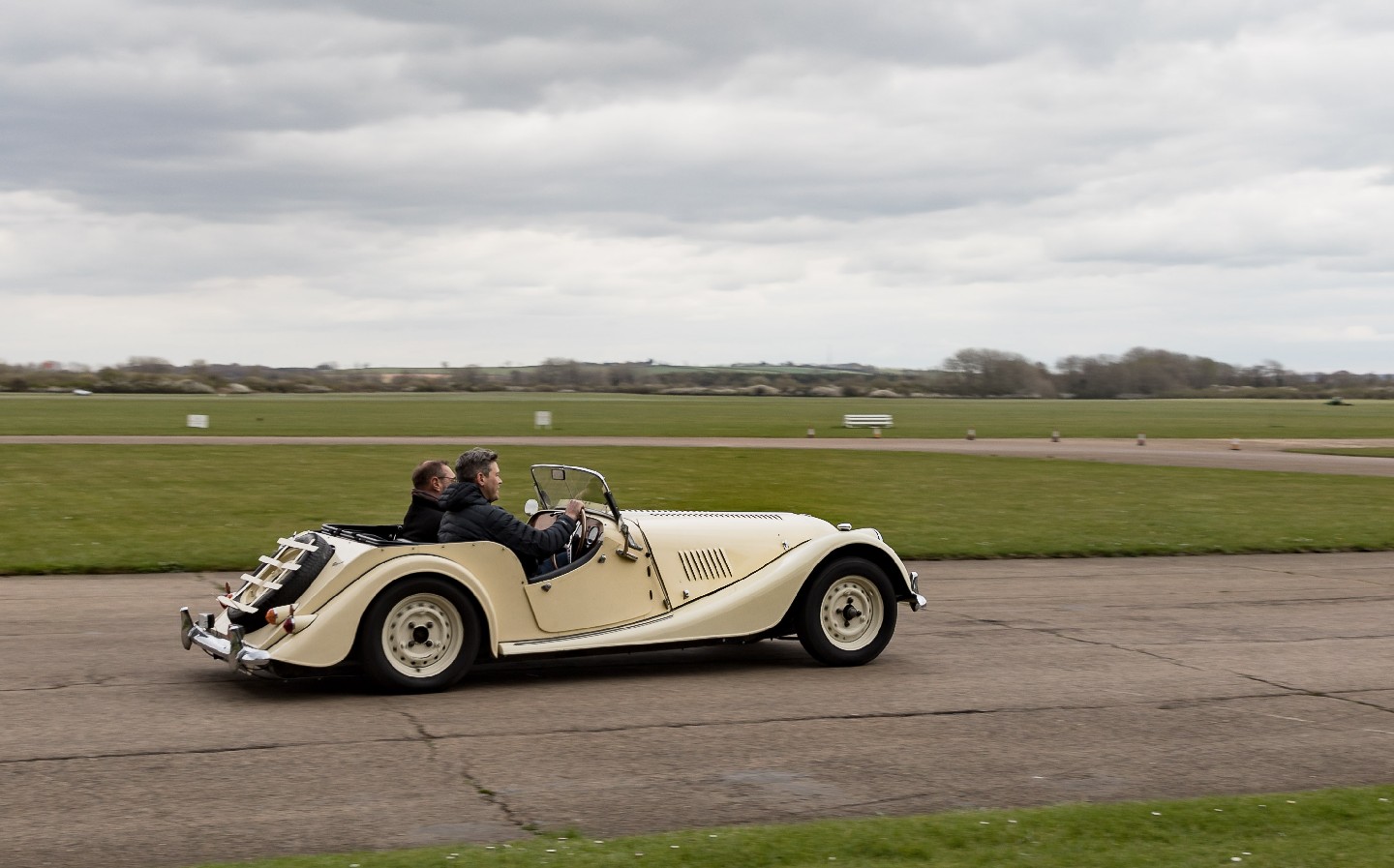
The Morgan and Triumph are crude to drive by modern standards — just like the petrol versions.
“It actually drives better than the original,” reckons Drummond. “We hooked it up to the 12-volt before we removed the engine, to test it, and the ride is actually firmer. It’s nicer.”
The cabins are largely kept original, though instruments will be made to work with the new drivetrains, including the rev meter. And of course a battery gauge is added. All the electrics are stripped out during a conversion as old wiring looms are often unreliable; it’s simpler and more robust to start again from scratch with modern kit.
Some things can’t — and perhaps shouldn’t — be changed
There are certain aspects that remain thoroughly un-modern in an electric conversion, though. The layout of the cockpit, for example. As a taller driver, ergonomics is not a plus point of either the Morgan or the Triumph, and squeezing my legs under the steering wheel required the skills of a contortionist.
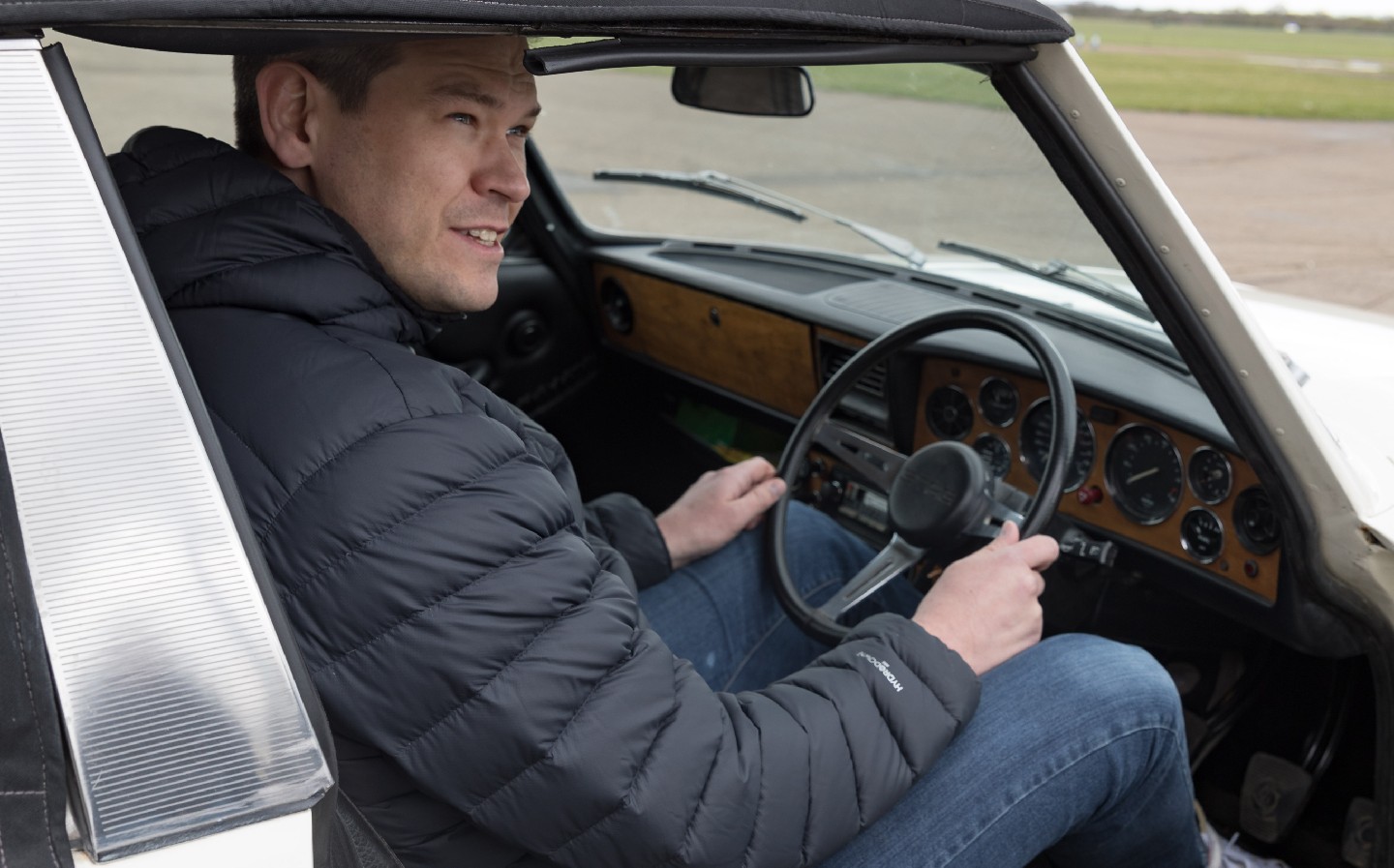
Ergonomics is not a strong suit of classic cars and that doesn’t change when they’re converted to electric.
And to drive, while the power delivery is smooth and punchy, there is still plenty of tyre noise and the rudimentary aerodynamics of the Morgan results in significant buffeting from the wind – at speed you struggle to hear the person sitting right next to you and breathing becomes difficult as air is forced into your lungs.
What’s more, by keeping the original suspension largely intact the ride is incredibly soft by modern standards, and cornering at pace results in significant body roll. The steering is heavy, the seats offer very little side support and the brakes are authentically crude, requiring significant pressure to bring the cars to a halt.
In short, this is still very much classic motoring – eccentric, uncomfortable but engaging, technical and terrifically old-school. It just comes with improved eco-credentials.
The growth of classic car electric conversion
Most experts agree that this is a burgeoning industry though data to back that up is hard to come by at present. Driving.co.uk has contacted the Society of Motor Manufacturers and Traders for any information on the scale of the market in the UK, and how it has changed over time, though there had been no response at the time of publication.
Drummond and Newstead say counting the number of firms converting classic cars to electric is difficult (“We make a distinction between people who have actually delivered a car to a customer and people who are talking about it”) but manage to reel off five well-established UK operators based in the UK, aside from themselves (see below). Each seems to have a different specialism, suggesting there are niches within this niche.
“Our first paying customer arrived a month before Covid lockdown”
It seems that there’s no shortage of demand from customers, both private and corporate (the Glastonbury music festival has commissioned three Land Rover Defenders for use on the estate, for example). The profile of classic car conversions also got a royal shot in the arm when the Duke and Duchess of Sussex climbed into an electric Jaguar E-type following their wedding in 2018.
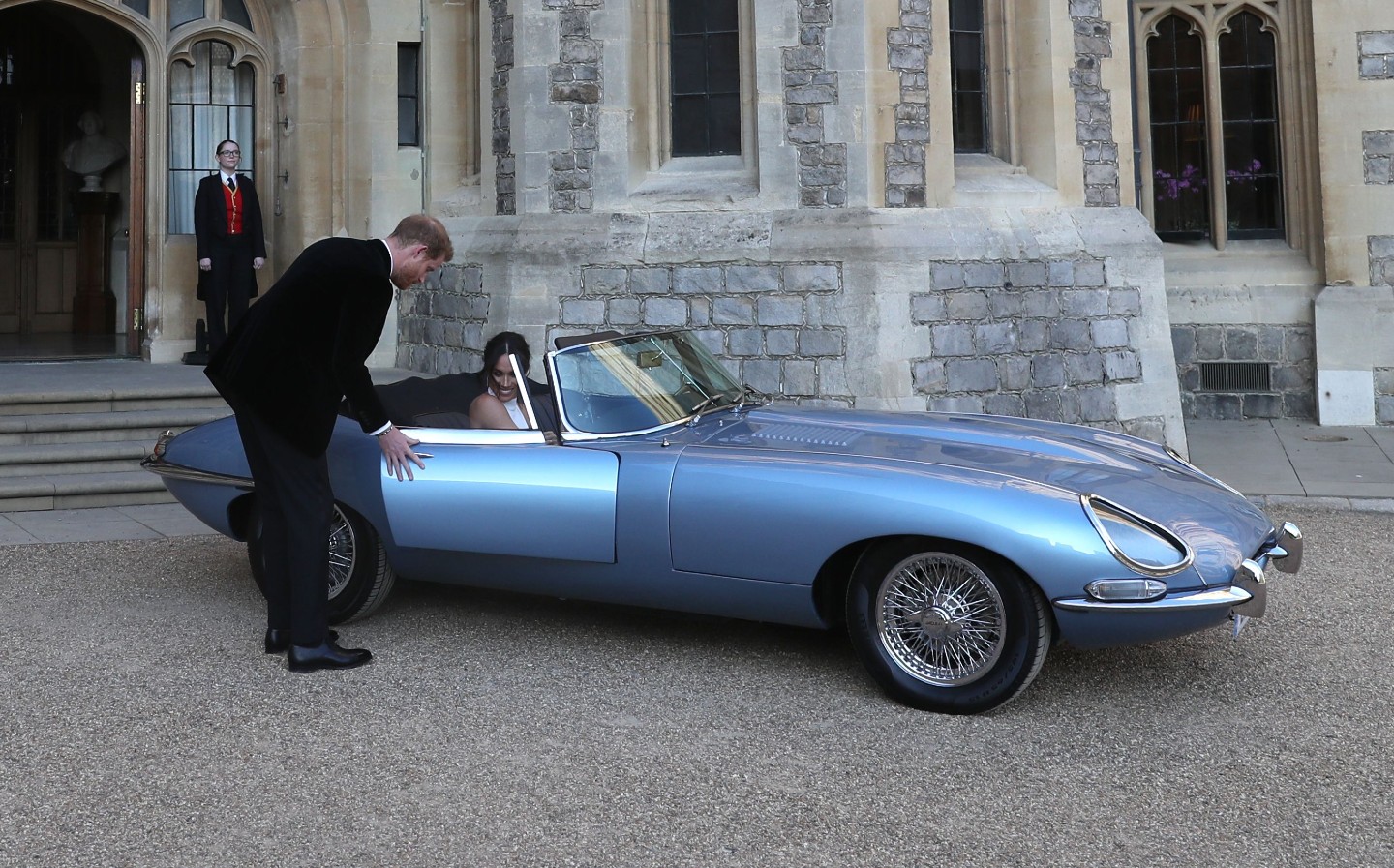
The Duke and Duchess of Sussex’s wedding car was an electric Jaguar E-type.
But although this is clearly a market with huge potential, of course the last 12 months have been tough for Electrogenic.
“Our first paying customer arrived a month before Covid lockdown,” says Drummond. “We got a big order; a whole bunch of corporate customers, actually. And we expanded our team from three people up to a dozen. But we didn’t submit the PAYE documents in until the end of March 2020 and that meant we missed the cut-off for furlough. So we paid the salaries all the way through first lockdown. It was all a bit scary.”
Even worse, all the corporate customers cancelled their orders in the first week of lockdown in 2020. Drummond says he didn’t have to take out any loans because “we’re just very efficient” and now that lockdown has eased, it’s full steam ahead once more.
“All bar one of the corporate clients have now returned, including Glastonbury,” he says, “And we’ve got another three starters joining this month.”
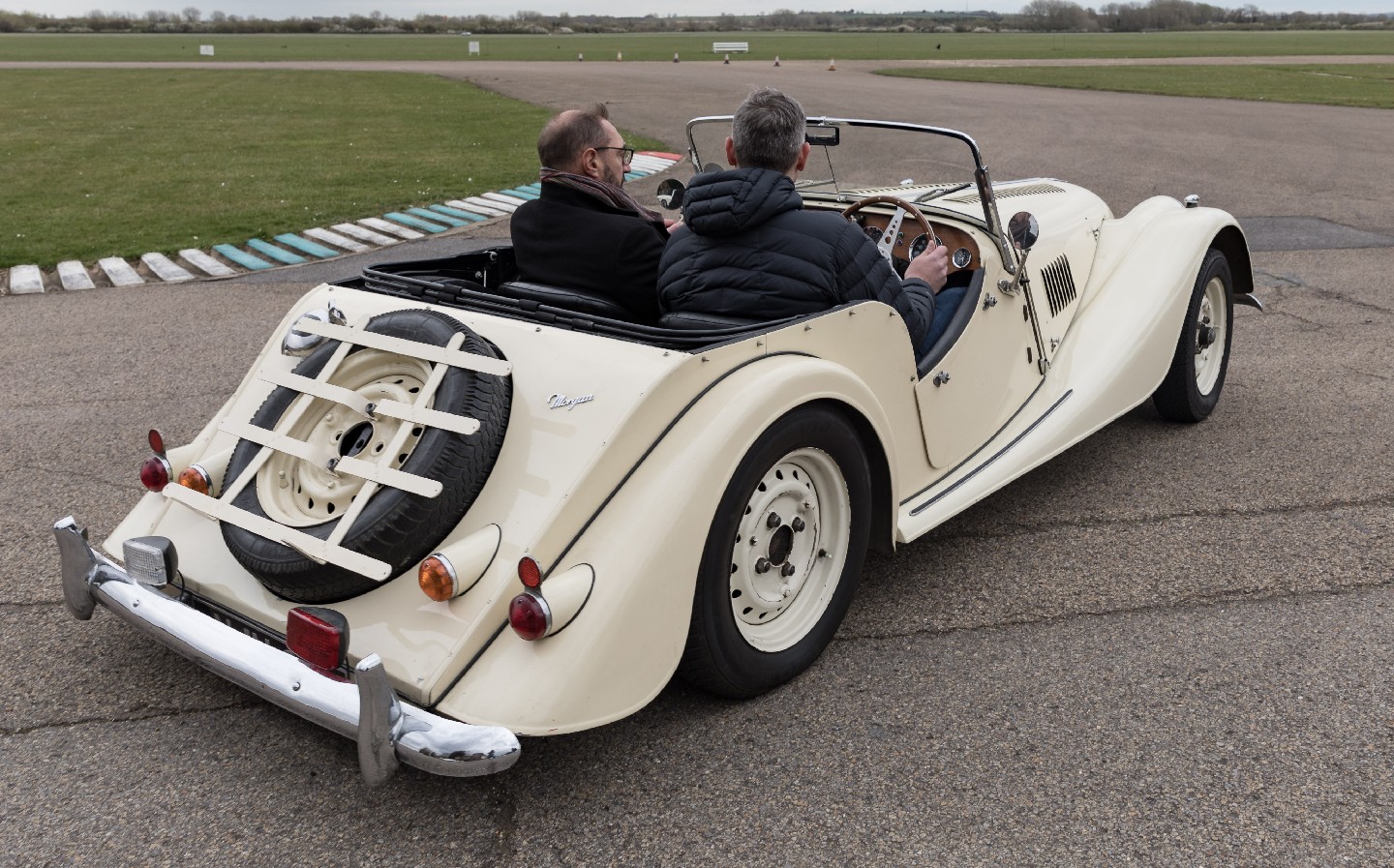
To the casual observer the electric conversions look identical to the originals.
Not only that but on the day of our visit last month, Electrogenic had picked up the keys to a new 9,000 square-foot premises next door to the existing workshop as part of its expansion. The firm also managed to retain a deal with Bicester Heritage for a marketing office and use of the track, which the company uses for testing vehicles.
How does electric conversion affect classic car values?
There’s not a great deal of information available in the public domain about how much an electrified classic car is worth. Even a leading car valuation expert wasn’t able to help in my quest, and one of the leading motor insurers — the first to offer dedicated electric car policies — said it doesn’t cover classic cars converted to run on electric power (even though it covers regular classic cars).
Fortunately, classic car specialist insurer Adrian Flux was much more helpful, providing values and policy costs before and after conversion for three of the classics I found in Electrogenic’s workshop. It’s pretty good news for the owner of the Porsche 356, as a 1964 Cabriolet valued at £80,000 in its original state would be worth £130,000-£140,000 after a £75,000 turnkey conversion by a specialist. Electrogenic might be able to do it for less than that, which would mean breaking even, or actually adding value.
Similarly, a Land Rover Series II worth £16,000 before conversion would be valued at £50,000-£60,000 if converted by a specialist for £45,000, which means it could make good financial sense.
But it’s not so smart for less valuable cars, it seems. A 1957 Morgan 4/4 is valued by Adrian Flux at £20,000 but after a basic conversion would be worth £30,000. The insurer said that doing the conversion yourself (assuming you have the skills), using quality parts, might cost £18,000, which would mean you’d lose both time and money in the process.
It’s also worth noting that insurance premiums go up after conversion. Assuming the cars are in good working condition when bought, that they’re used as a second vehicle by a driver in their 50s with a clean licence and secure private parking, and based on a limit of 3,000 miles per year, the Morgan’s annual insurance premium would rise from £105 to £195, the Land Rover’s from £96 to £245 and the Porsche’s from £280 to £580.
The future of electric classic car conversions
What does the future hold for Electrogenic, I ask. “The future is electric,” quips Drummond with a smile.
But can they see a time when all classic cars will be converted to electric, due to increasingly stringent emissions regulations?
“Not all of them, I don’t think,” says Newstead. “Some of them will. Some people will want to keep them classic, but I don’t think they’ll be allowed on the road.
“Bicester Heritage is future-proofing right now and one of their thoughts is that it’s likely that to drive an internal combustion engine car, you’re going to have to have a licence and it’s going to be a constrained activity allowing you to drive it in a specific place and maybe not anywhere else. Race tracks probably. Silverstone, that sort of thing.”
Such an eventuality would mean that companies like Electrogenic are likely to have a very bright future indeed, though it will undoubtedly be an uncomfortable thought for some classic car owners.
Classic car electric conversion firms in the UK
- Electrogenic: Established at the end of 2017, Oxfordshire-based Electrogenic will convert almost any classic car to electric power, and have developed a lot of their own parts and electronics. Although they offer a bespoke service according to the customer’s instructions, the exact specification of the conversion is a “conversation”, with guidance offered by the experts. Costs start at around £30,000 but will go much higher, depending on the job. https://www.electrogenic.co.uk/
- London Electric Cars: Based in Elephant and Castle, south east London, this company specialises in classic Minis, Land Rovers, Morris Minors, Morris Travellers and Vans. Costs start at £22,000 for the most basic conversion but again, this is a bespoke service so costs vary depending on specification. A budget of £25,000 “for an appropriate conversion and other sympathetic upgrades” is recommended. https://www.londonelectriccars.com/
- Electric Classic Cars: The oldest one classic car electric conversion specialist in the UK is based in Powys, Wales. The company has an activate YouTube channel and is known for exciting conversions such as a ludicrously-fast Tesla-powered VW Beetle, though a wide range of vehicles have been converted, from a Ferrari 308 to a Fiat 500. If you don’t have your own classic car, one can be sourced for you. The firm will also happily supply you with parts for your own home-made conversion. https://www.electricclassiccars.co.uk/
- RBW Electric Classic Cars: At the moment RBW specialises in building MGB Roadster and GT lookalikes using classic shells but modern engineering and technology underneath, though other models are now being introduced including electric Jaguar E-types. It has partnered with Continental on the engineering side (tyres are only one part of its business). https://rbwevcars.com/
- Lunaz: Based at Silverstone Circuit, Northamptonshire, Lunaz specialises in high end and luxury classics from the likes of Rolls-Royce, Jaguar, Range Rover and Bentley. The company describes its work as “uncompromised expressions of the original” and as such, prices are thought to be well into six figures. https://lunaz.design/
- Zero EV: This Bristol-based company offers a bespoke high-end conversion service using Tesla-based components with custom-made control systems, but its core business is as a parts supplier, re-manufacturing car maker parts for use in electric vehicle conversions. It also offers training and support for end users. https://zero-ev.co.uk/
Enjoyed reading about classic car electric conversions? Then you might also like to read about EVs with the longest range.
If you’re looking to head out this summer, check out our list of the best classic car shows.
In the market for a new electric car? Read our review of the 2020 Skoda Octavia iV Estate plug in hybrid here.


